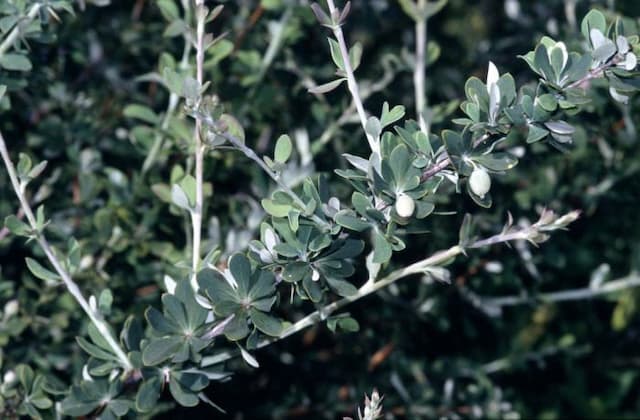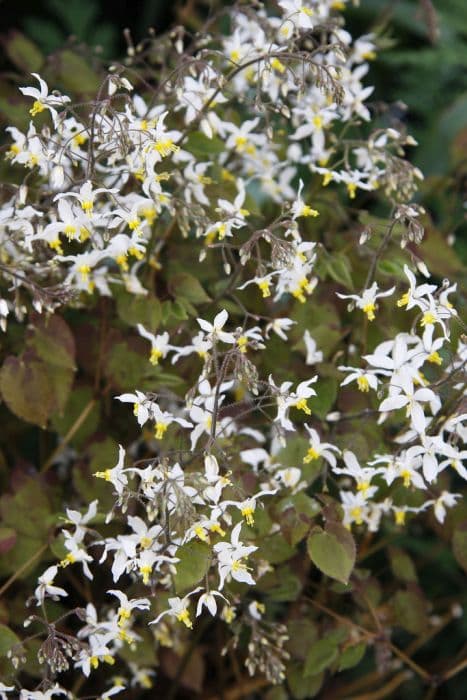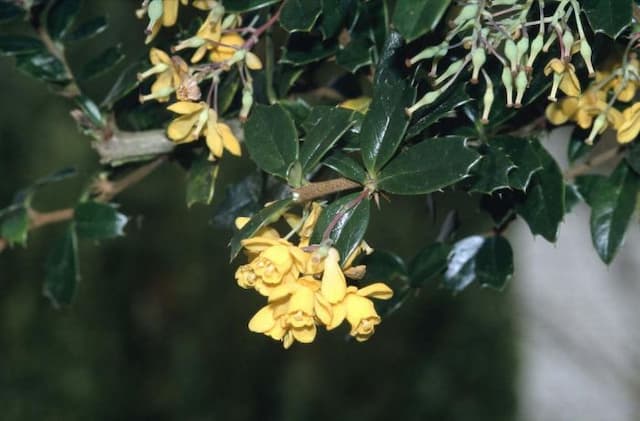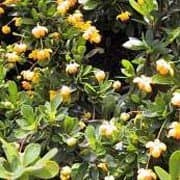Kaleidoscope Mayapple Podophyllum 'Kaleidoscope' (v)

ABOUT
The Podophyllum 'Kaleidoscope', known commonly as the Mayapple, is a distinctive perennial plant with a striking appearance. It features large, umbrella-like leaves that are deeply lobed and often exhibit a pattern that suggests they've been splashed with varying shades of green, bronze, and silver, creating a visual effect that is reminiscent of a kaleidoscope pattern. These leaves are often mottled and marbled, enhancing the ornamental value of the plant. As the Mayapple grows, it can form a lush, leafy canopy that offers a bold textural contrast in shaded garden areas. In spring, the Mayapple produces drooping flowers which tend to be hidden beneath its grand leaves, adding a subtle charm to the plant. The flowers are usually white or soft pink and later in the season, give way to fleshy, apple-like fruit that provides additional visual interest. However, it's important to note that while the Mayapple is a unique and attractive plant, all parts of it are toxic if ingested, except for the ripe fruit which should still be handled with caution. The overall aesthetic of the Mayapple 'Kaleidoscope' is one of woodland beauty and complexity, lending a mysterious and almost fairy-tale-like quality to the environments where it thrives.
About this plant
 Names
NamesFamily
Berberidaceae.
Synonyms
Kaleidoscope Mayapple, Kaleidoscope Mandrake.
Common names
Podophyllum 'Kaleidoscope'.
 Toxicity
ToxicityTo humans
Podophyllum 'Kaleidoscope', more commonly known as Mayapple, is a plant with a certain level of toxicity to humans. All parts of the Mayapple plant, especially the unripe fruit and the rhizome, contain podophyllotoxin, which is a toxic substance. If ingested, it may cause symptoms such as diarrhea, vomiting, headache, low blood pressure, difficulty breathing, and fever. In severe cases, consuming the Mayapple plant can result in multi-organ failure or even be fatal. Therefore, accidental ingestion of any part of the Mayapple plant should be treated as a medical emergency and prompt medical attention should be sought.
To pets
Mayapple is toxic to pets due to the presence of podophyllotoxin in the plant's parts, especially the unripe fruit and the rhizome. If pets ingest Mayapple, they may exhibit symptoms like vomiting, diarrhea, lethargy, and possibly seizures. In severe cases, ingestion of this plant may lead to organ damage or failure, and can be life-threatening. Owners should prevent their pets from having access to any part of the Mayapple plant and seek immediate veterinary care if ingestion is suspected.
 Characteristics
CharacteristicsLife cycle
Perennials
Foliage type
Deciduous
Color of leaves
Mixed
Height
1-2 feet (30-60 cm)
Spread
1-2 feet (30-60 cm)
Plant type
Herb
Hardiness zones
5-9
Native area
North America
Benefits
 General Benefits
General Benefits- Ornamental Appeal: Variegated leaves offer visual interest in shade gardens or woodland settings.
- Drought Tolerance: Once established, it requires less watering, making it suitable for xeriscaping.
- Low Maintenance: Requires minimal care beyond basic watering and occasional fertilizing.
- Shade Tolerance: Thrives in shady areas where other plants may struggle to grow.
- Seasonal Interest: Provides changing colors and textures throughout the growing season.
- Wildlife Attraction: Flowers can attract pollinators, enhancing local biodiversity.
- Ground Cover: Can be used to cover bare spots in the garden, minimizing weed growth.
- Container Gardening: Suitable for planting in pots or containers for patios and balconies.
 Medical Properties
Medical PropertiesThis plant is not used for medical purposes.
 Air-purifying Qualities
Air-purifying QualitiesThis plant is not specifically known for air purifying qualities.
 Other Uses
Other Uses- Ornamental: The Podophyllum 'Kaleidoscope', commonly known as Mayapple, is often used in shade gardens and woodland settings for its unique foliage and attractive flowers.
- Seasonal Interest: With its changing foliage through the seasons, Mayapple adds aesthetic interest to gardens, transitioning from green to variegated as the season progresses.
- Ground Cover: Mayapple is an effective ground cover in shaded areas where other plants might struggle to thrive, forming dense colonies that suppress weeds.
- Landscape Design: Garden designers use Mayapple for creating texture contrasts with its deeply lobed leaves against fine-leaved shade plants.
- Companion Planting: Mayapple pairs well with other shade-loving perennials, such as hostas and ferns, enhancing the biodiversity of garden habitats.
- Erosion Control: The spreading habit and dense foliage of Mayapple can help prevent soil erosion in shaded sloped areas.
- Photography: Its unique appearance and rarity of blooming make Mayapple a favorite subject for nature photographers during springtime.
- Educational Tool: Mayapple can be used in educational gardens to teach about native woodland species and their role in plant communities.
- Bee foraging: While not a major source, the flower of Mayapple provides forage for native bees early in the season when other food sources are scarce.
- Cultural Significance: Mayapple has historical relevance and can be used to teach about the plant's use and symbolism in Indigenous cultures of North America.
Interesting Facts
 Feng Shui
Feng ShuiThe Mayapple is not used in Feng Shui practice.
 Zodiac Sign Compitability
Zodiac Sign CompitabilityThe Mayapple is not used in astrology practice.
 Plant Symbolism
Plant Symbolism- Healing: The "Mayapple" is often associated with medicinal properties, and in some cultures, its use in remedies signifies the power of healing.
- Protection: Carrying parts of the Mayapple plant has historically been thought to keep away negative spirits or influences, symbolizing protection.
- Hidden Potential: Since the fruit of the Mayapple is not immediately visible due to the umbrella-like leaves, it represents things that are not initially seen but hold potential.
 Water
WaterThe mayapple should be watered regularly, aiming to keep the soil consistently moist but not water-logged. During the growing season, from spring to fall, you may find yourself watering the plant approximately once a week, or as needed to maintain soil moisture. This can equate to about 1 to 2 gallons depending on the size of the plant and environmental conditions. In winter, the plant's watering needs decrease, and you should reduce the frequency, providing water only if the soil appears dry. It's important not to let the mayapple's soil dry out completely, as it prefers a humid environment.
 Light
LightMayapples thrive best in part shade to full shade conditions. They should be planted in a spot that receives filtered sunlight or is shaded for a large part of the day, as direct sunlight can be too intense and may scorch the leaves. The ideal location often mimics their natural woodland habitat, where they receive dappled light through the canopy.
 Temperature
TemperatureMayapples are suited to a wide range of temperatures and can survive in a temperature range from as low as 20 degrees Fahrenheit up to 90 degrees Fahrenheit. However, they typically prefer cooler conditions and the ideal temperature for these plants hovers between 60 to 75 degrees Fahrenheit. Protecting them from extreme cold and frost is important, although they enter a dormancy period in winter and can survive short cold spells.
 Pruning
PruningPruning of mayapples generally involves removing dead or damaged foliage to maintain the plant's health and appearance. This is best done in late winter or early spring before new growth begins. Pruning isn't frequently necessary, but if the plant becomes too large or unruly, it can be cut back to shape it. Always use clean, sharp pruning tools to make precise cuts.
 Cleaning
CleaningAs needed
 Soil
SoilMayapple 'Kaleidoscope' prefers a soil mix that is rich in organic material, well-draining yet moisture-retentive. An ideal soil mix can be created using equal parts of loam, peat, and perlite. Additionally, incorporating compost can provide the necessary nutrients. The best soil pH for Mayapple 'Kaleidoscope' is slightly acidic to neutral, ranging from 5.5 to 7.0.
 Repotting
RepottingMayapple 'Kaleidoscope' generally does not require frequent repotting; it can be done every 2-3 years. Care should be taken not to disturb the rhizomes excessively during the repotting process, as they are sensitive.
 Humidity & Misting
Humidity & MistingMayapple 'Kaleidoscope' thrives best in environments with high humidity, ideally between 60 to 80%. Keeping the surrounding air moist will help mimic its natural habitat and promote vigorous growth.
 Suitable locations
Suitable locationsIndoor
Place in bright, indirect light and keep the soil moist.
Outdoor
Provide dappled shade and moist, well-draining soil.
Hardiness zone
4-8 USDA.
 Life cycle
Life cyclePodophyllum 'Kaleidoscope', commonly known as Mayapple, begins its life cycle when its rhizomes (underground stems) sprout in early spring, pushing up umbrella-like, lobed leaves. Once mature, the plants produce small white to pink flowers from the axils of the leaves, generally hidden beneath the foliage. Following pollination, usually by bumblebees or other insects, the flowers develop into fleshy, yellowish-green fruit by late summer. The fruit is edible when completely ripe, but the rest of the plant contains toxic substances; the seeds within the fruit are dispersed by wildlife. During the winter, the above-ground part of the Mayapple dies back, leaving the perennial rhizomes to overwinter in the soil. Every spring, new growth emerges from these rhizomes, completing the cycle.
 Propogation
PropogationPropogation time
Spring-Early Summer
The Podophyllum 'Kaleidoscope', commonly known as Mayapple, is typically propagated through division of rhizomes, which is considered to be the most popular method for this particular plant. The best time to propagate the Mayapple by division is in late summer to early fall, after the plant has gone dormant. During this period, the rhizomes can be carefully unearthed and cut into sections, ensuring that each piece has at least one growth bud. These sections are then replanted at a depth of about 2 to 3 inches (5 to 7.6 centimeters) in a well-draining soil mix. It is important to maintain consistent moisture levels without waterlogging the soil as the new divisions establish themselves. The propagated plants should be kept in a shaded or partially shaded area as they can be sensitive to direct sunlight. Patience is required, as it may take a few seasons for the new plants to flower and reach maturity.









